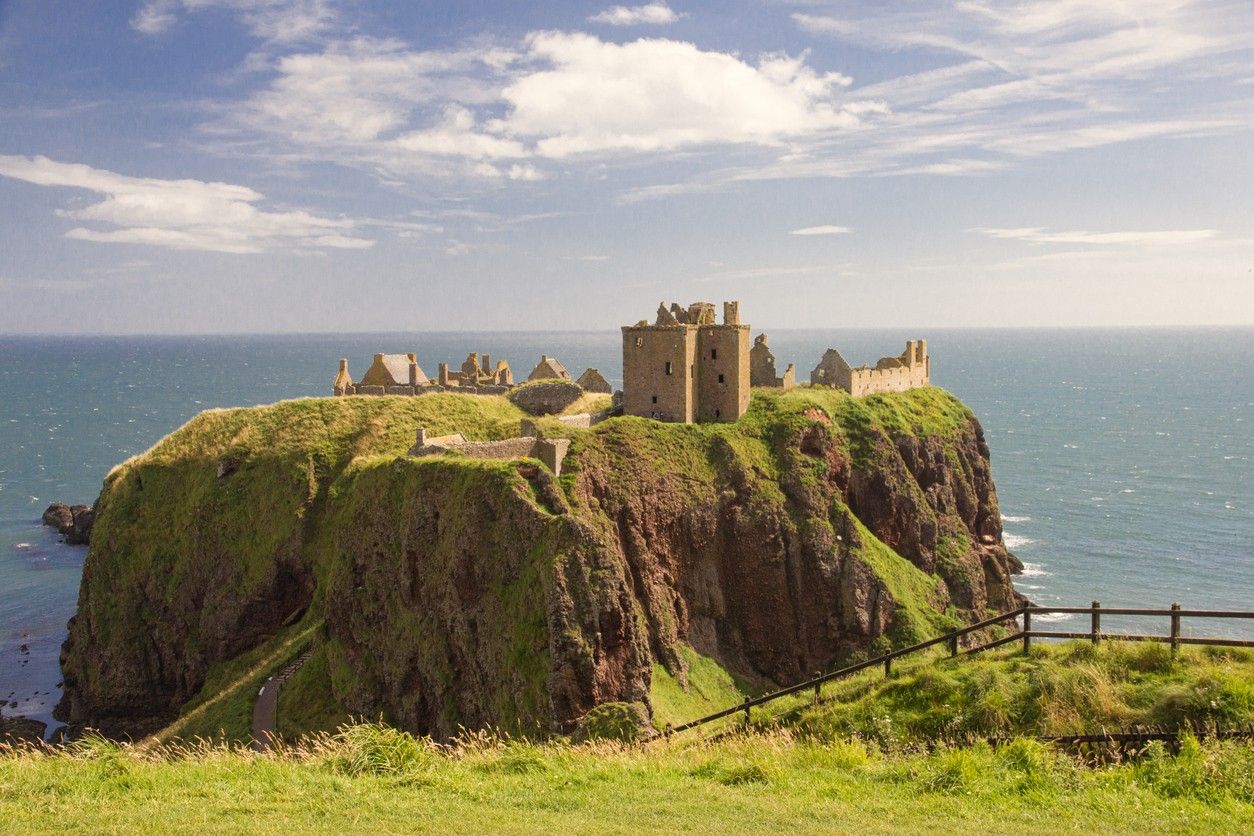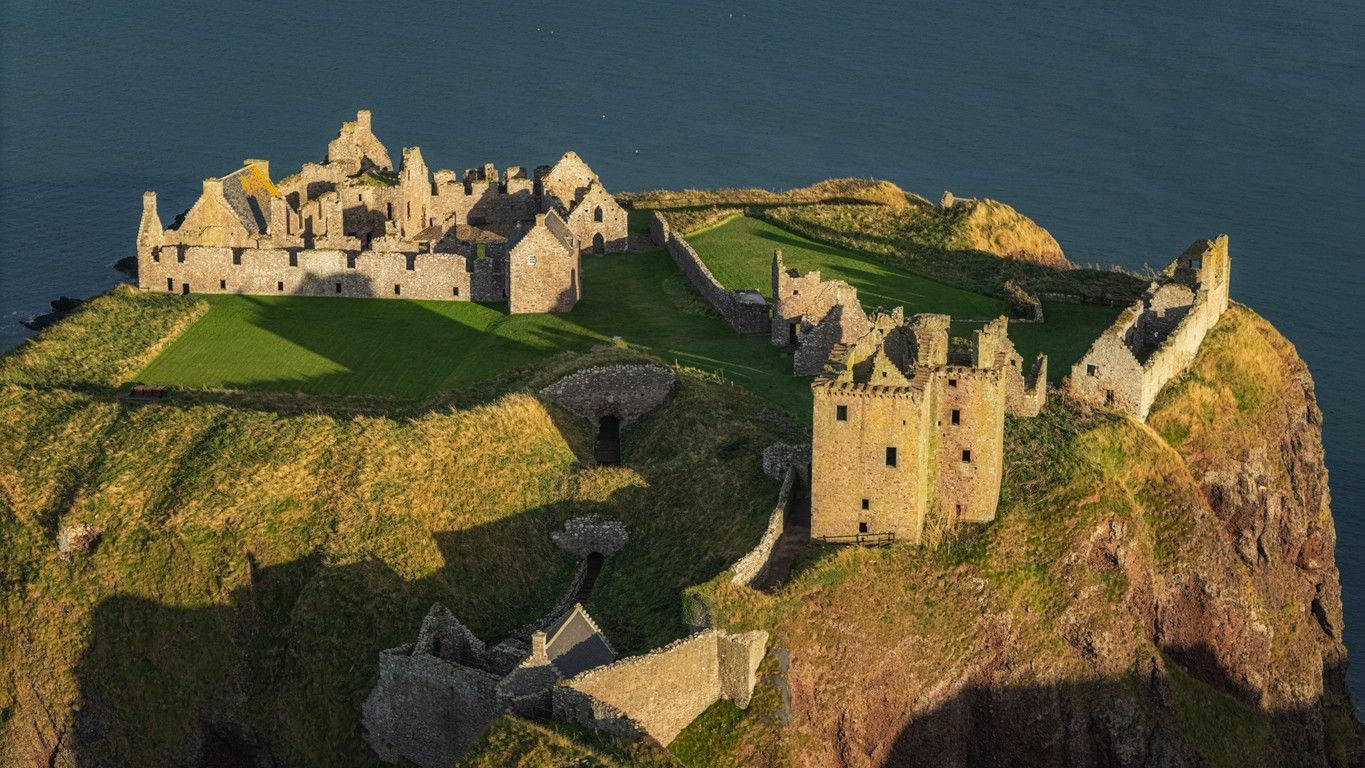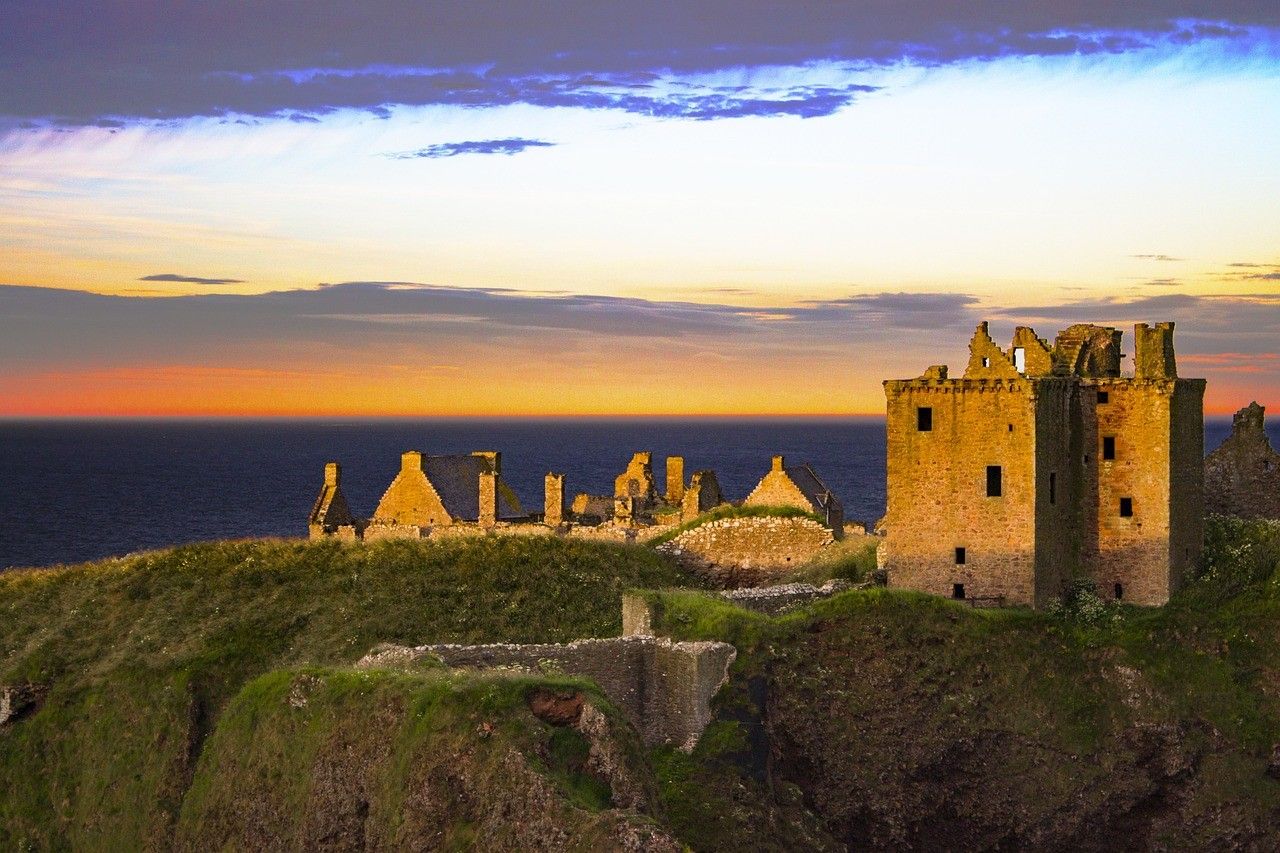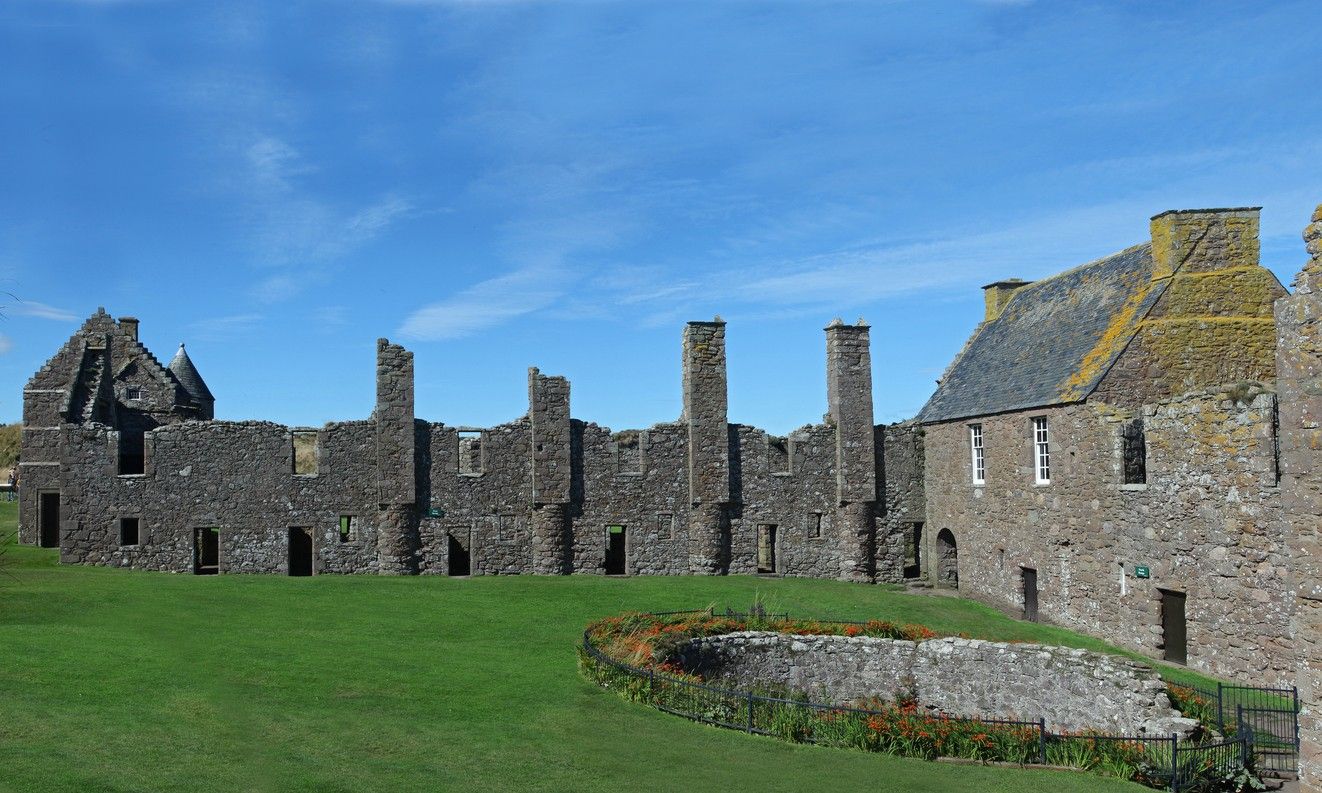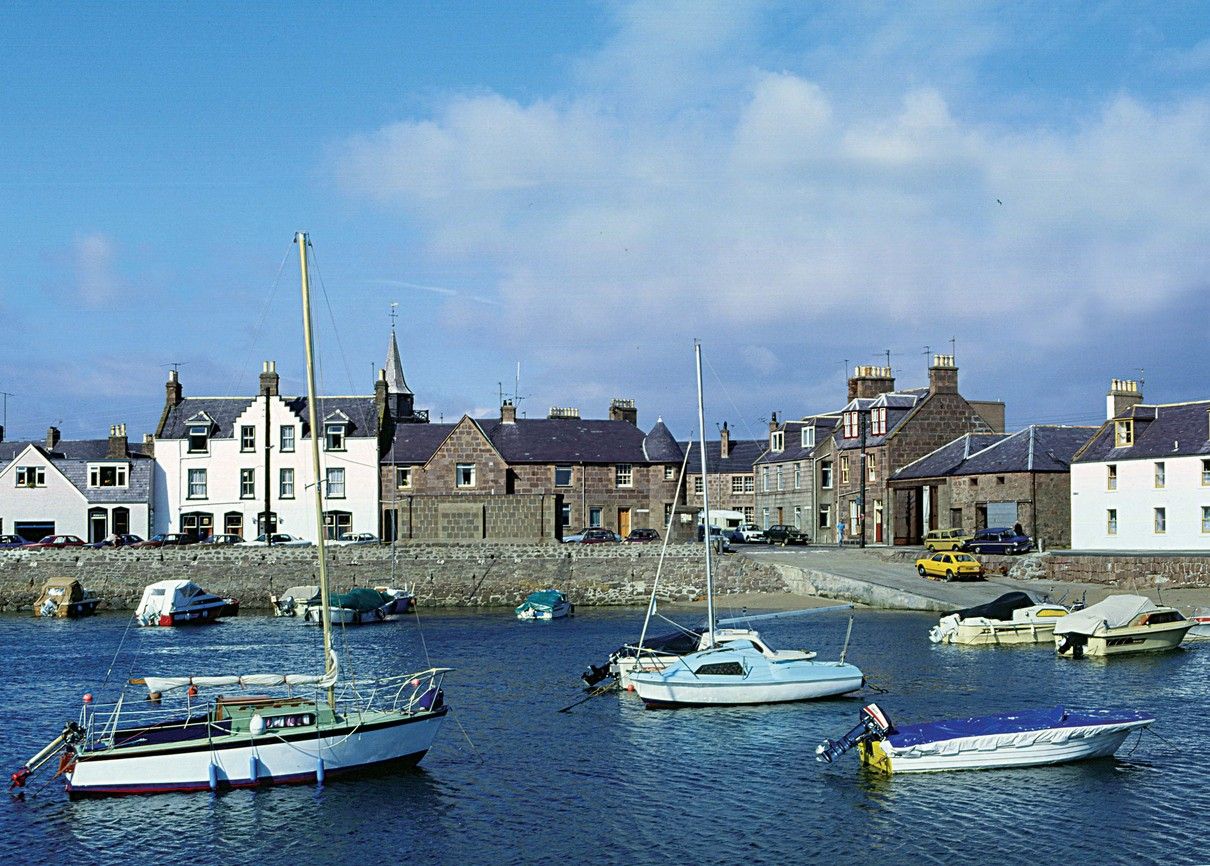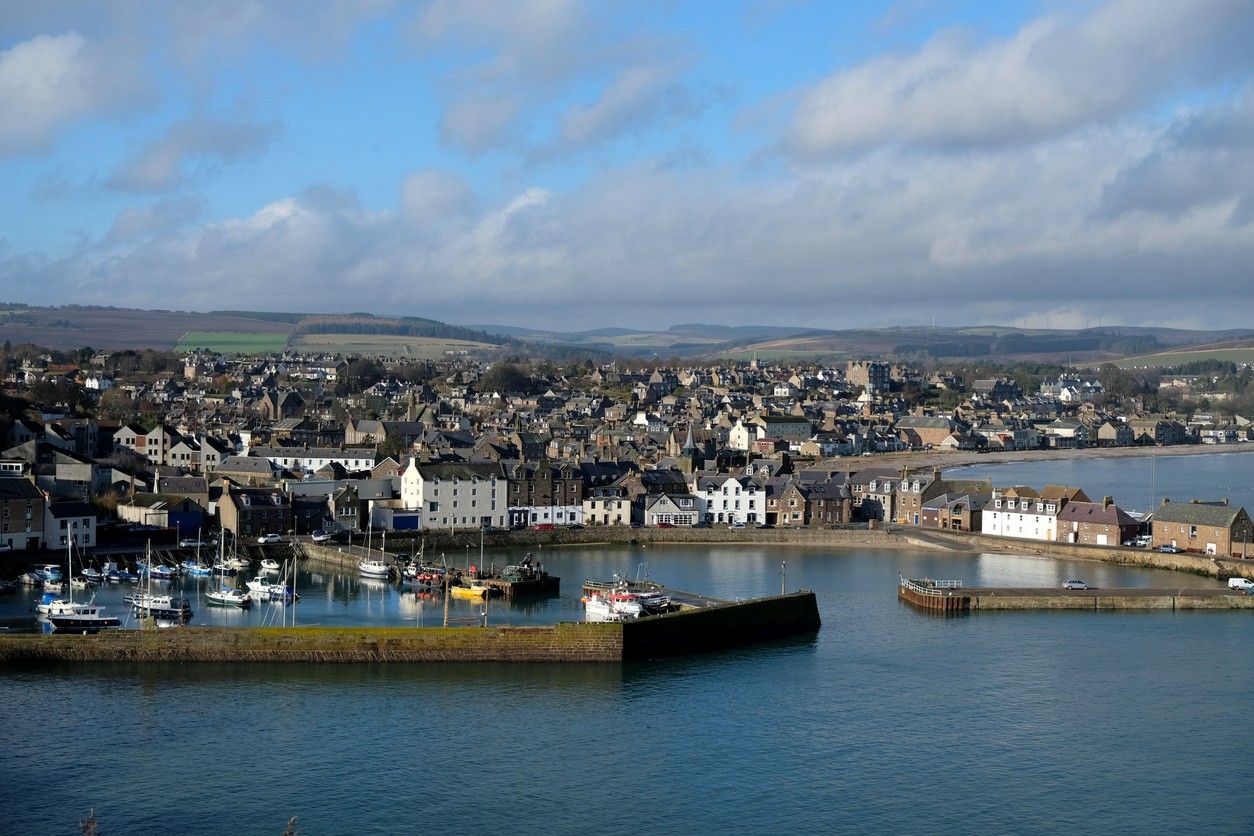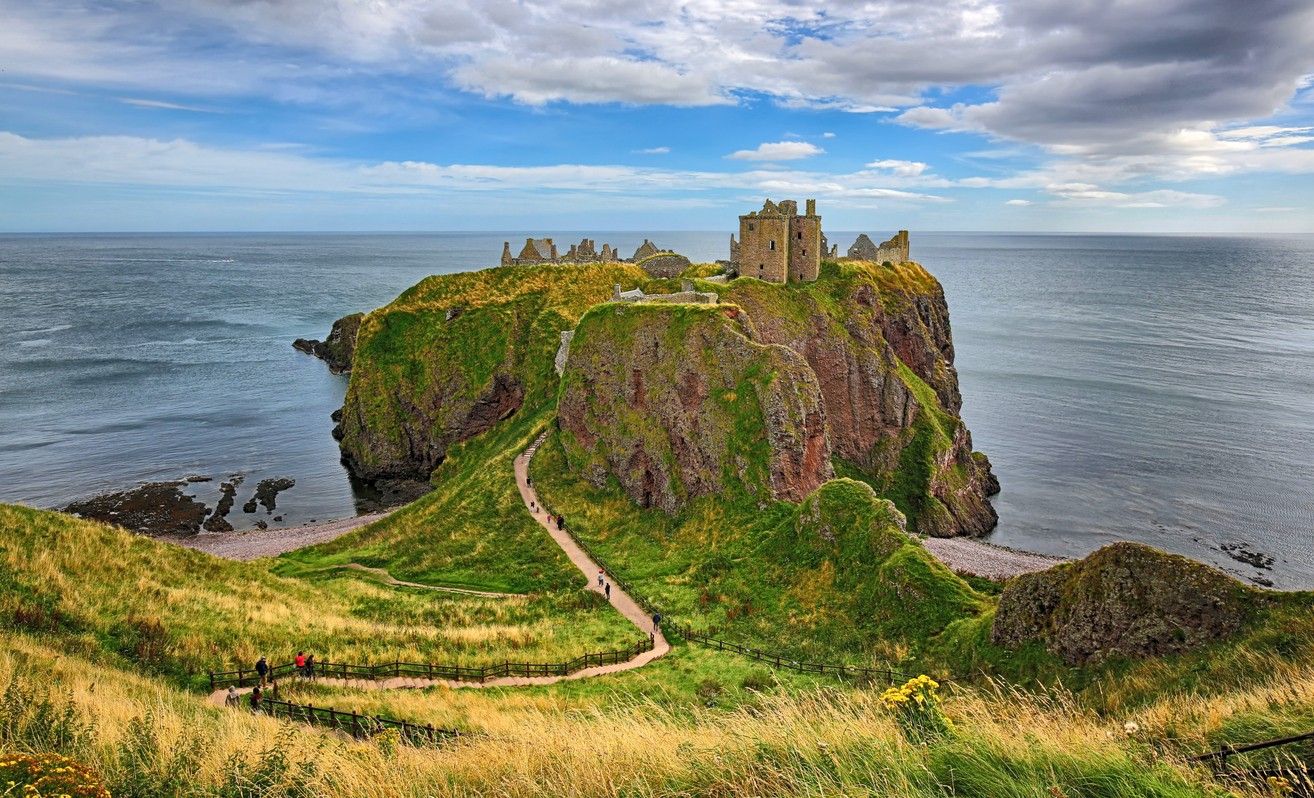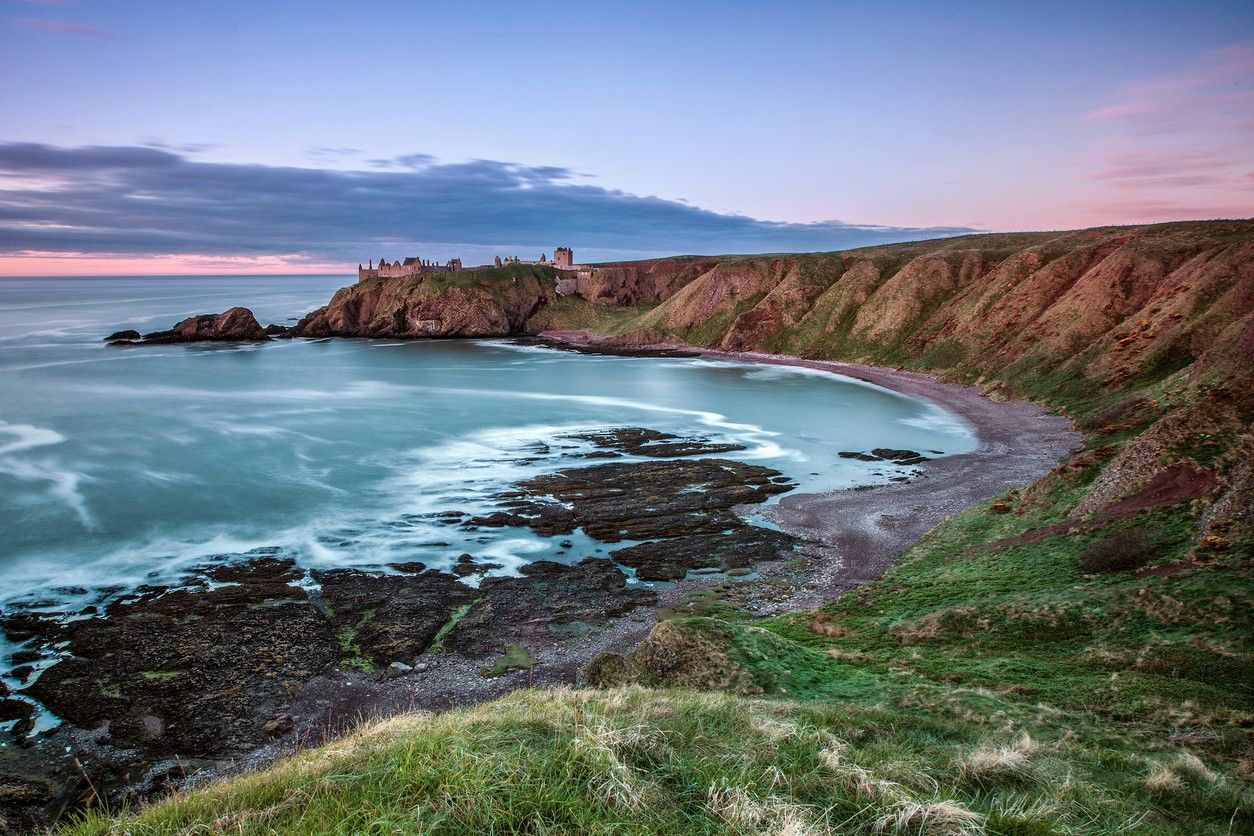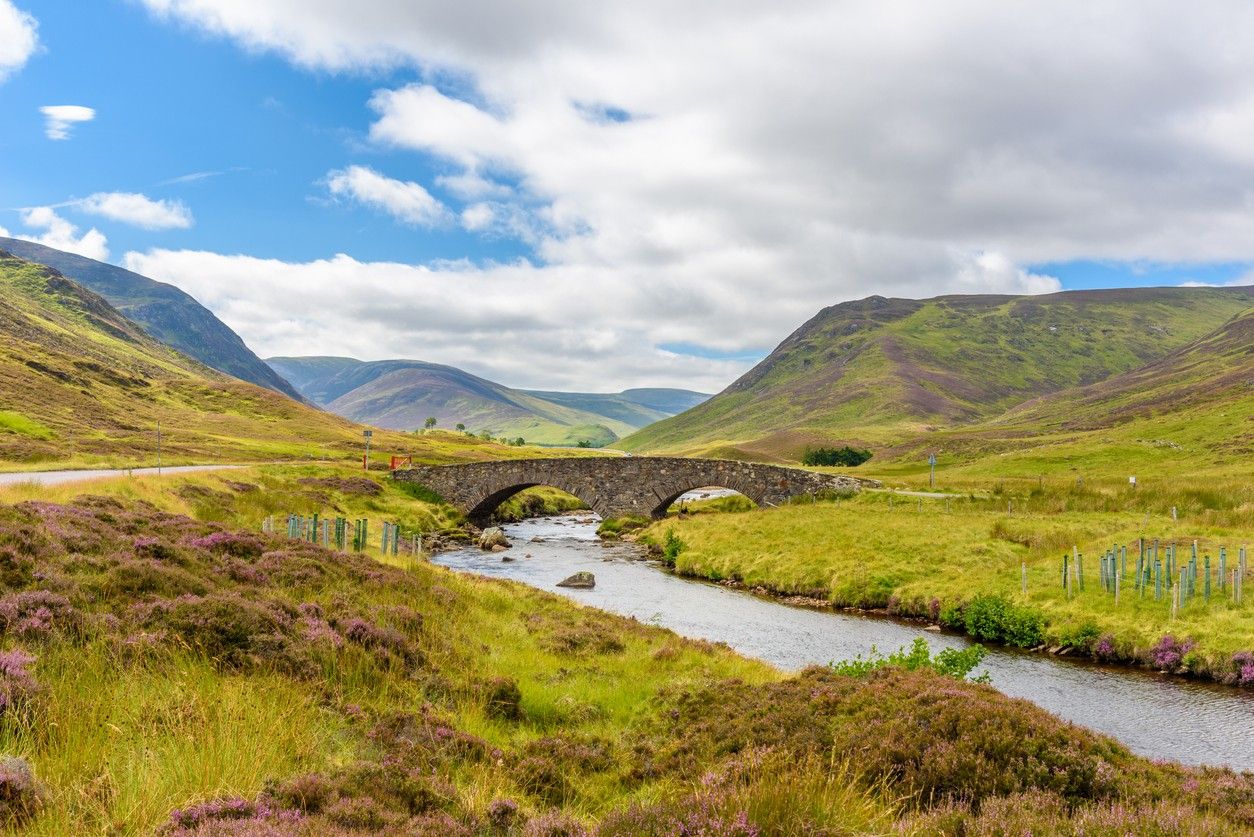Perched atop a rocky headland, the majestic Dunnottar Castle stands as a testament to Scotland's rich history and the enduring spirit of its people. This awe-inspiring fortress, located in the charming coastal town of Stonehaven, has borne witness to some of the nation's most significant events, from battles and sieges to the preservation of the crown jewels. Visitors to Dunnottar Castle are transported back in time, where the echoes of the past whisper tales of heroism, intrigue, and the unwavering determination that has defined Scotland's journey.
Origins & History of Dunnottar Castle
The origins of Dunnottar Castle can be traced back to the 5th century when a Pictish fort was first established on the strategic, rocky headland overlooking the North Sea. This formidable position, with its unparalleled vantage point and natural defences, made it an ideal location for a stronghold, and over the centuries, the site has borne witness to some of the most pivotal moments in Scottish history. In the 9th century, as the Kingdom of Scotland began to take shape, Dunnottar Castle emerged as a critical power centre, serving as a seat of the Mormaers (later Earls) of Buchan. The castle's strategic importance only grew in the following centuries, as it became a vital defensive outpost during the Wars of Scottish Independence in the 13th and 14th centuries. During this tumultuous period, the castle changed hands numerous times, with both the Scots and the English vying for control of this influential fortress. One of the most significant events in Dunnottar Castle's history occurred in the 17th century when the castle played a pivotal role in the preservation of the Scottish crown jewels. As Oliver Cromwell's forces invaded Scotland and threatened to seize the precious regalia, including the famed Stone of Destiny, the castle's governor, George Ogilvie, orchestrated a daring plan to hide the jewels within the castle's walls. This act of defiance and patriotism ensured that the crown jewels were safeguarded and eventually returned to their rightful place, a testament to the castle's enduring importance in Scottish history.
Throughout the centuries, Dunnottar Castle has been controlled by a succession of noble families, each of whom has left their mark on the fortress. The Keiths, Earls Marischal of Scotland, were perhaps the most influential of these families, transforming the castle into a formidable stronghold and a hub of political and cultural activity. The castle's architectural evolution reflects this rich history, with various styles and additions incorporated over time to meet the changing needs and aspirations of its occupants. Today, Dunnottar Castle stands as a captivating relic of Scotland's past, a testament to the resilience and determination of its people. From the Pictish fort of the 5th century to the castle's role in the preservation of the Scottish crown jewels, Dunnottar Castle remains a powerful symbol of Scotland's enduring spirit and the unwavering determination that has defined its journey through the ages.
Exploring the Impressive Architecture of Dunnottar Castle
The castle's strategic location, perched atop a rugged, rocky promontory, grants it an air of impregnable strength and resilience, a fitting reflection of the fortress's long and storied history. The castle's impressive remains feature a diverse array of architectural styles, reflecting the various periods of its evolution over the centuries. The earliest structures on the site, dating back to the Pictish fort of the 5th century, were likely constructed using local stone and timber, designed to take advantage of the site's natural defences and commanding views of the surrounding coastline. In the medieval period, as the castle's significance as a strategic stronghold grew, the architectural features of Dunnottar began to reflect the evolving military and defensive requirements of the time. The construction of the castle's sturdy curtain walls, punctuated by sturdy towers and gatehouses, served to fortify the site and enhance its ability to withstand sieges and attacks.
One of the most iconic architectural features of Dunnottar Castle is the Cheyneys Tower, a distinctive round tower that has become a symbol of the fortress. This impressive structure, dating back to the 15th century, was once a vital part of the castle's defences, serving as a watchtower and a means of communication with the surrounding countryside. The tower's unique design, with its striking silhouette and sturdy construction, is a testament to the ingenuity and skill of the castle's medieval builders. As the castle's ownership passed through the hands of various noble families, notably the Keiths, and Earls Marischal of Scotland, the architectural features of Dunnottar continued to evolve. The castle's residential buildings, once grand structures that housed the noble families and their retinues, now stand in evocative ruin, their crumbling walls and scattered architectural fragments offering a glimpse into the lives of those who once called this fortress home. The castle's impressive gatehouse, with its striking archway and defensive features, is another architectural highlight that showcases the skill and craftsmanship of the castle's builders. Visitors can explore the intricate vaulted ceilings and the remains of the castle's former offices and living quarters, gaining a deeper understanding of the daily life and operations within the fortress.
The Grounds of Dunnottar Castle
The castle's strategic location, situated on a rocky headland, presents visitors with a unique and breathtaking vantage point, offering panoramic views of the North Sea and the surrounding countryside. One of the most captivating features of the castle's grounds is the network of winding paths and stairways that allow visitors to navigate the various levels of the site. These pathways offer a glimpse into the castle's past, as they lead visitors through the remains of ancient structures, including the impressive remains of the medieval chapel and the haunting ruins of the once-grand residential buildings. Visitors can also explore the castle's natural surroundings, which are equally as captivating as the man-made structures. The rugged coastline, with its dramatic cliffs and crashing waves, provides a stunning backdrop to the castle, and the lush, verdant landscapes that surround the site offer opportunities for peaceful reflection and exploration.
Dunnottar Castle’s Ruins
These ruins, each with its unique history and significance, offer a window into the castle's turbulent past and the challenges it has faced over the centuries. One of the most haunting and poignant ruins within the castle's grounds is the remains of the medieval chapel, which once stood as a sacred space for the castle's inhabitants. The chapel's crumbling walls and the scattered remnants of its ornate architectural features serve as a powerful reminder of the castle's religious and cultural significance. Another captivating ruin is the remains of the castle's former residential buildings, which once housed the noble families and their retinues. These structures, with their crumbling walls and overgrown foundations, provide a glimpse into the daily lives of those who called Dunnottar Castle home, and the challenges they faced in maintaining their stronghold in the face of constant threat and upheaval.
Discovering the Breathtaking Coastal Views from Dunnottar Castle
One of the most captivating aspects of visiting Dunnottar Castle is the opportunity to experience the breathtaking coastal views that surround the site. Perched atop a rugged headland, the castle commands an unparalleled vantage point, offering visitors panoramic views of the North Sea and the stunning, rocky coastline that stretches out in both directions. As visitors traverse the castle's grounds, they are treated to a succession of awe-inspiring vistas, each one more captivating than the last. From the dramatic cliffs that plunge into the crashing waves below to the sweeping vistas of the distant horizon, the coastal views from Dunnottar Castle are truly unforgettable. The castle's strategic location, with its commanding views and proximity to the sea, has long been a key factor in its historical significance. The ability to monitor the surrounding waters and quickly respond to any threats made Dunnottar Castle an invaluable asset for the noble families and armies who have controlled it over the centuries.
What are the Local Attractions Surrounding Dunnottar Castle?
While Dunnottar Castle is undoubtedly the main draw for visitors to the area, the surrounding region of Stonehaven and Scotland offers a wealth of additional attractions and experiences that are well worth exploring.
Charming Stonehaven
Just a short distance from the majestic Dunnottar Castle lies the charming coastal town of Stonehaven, a picturesque gem that has long been a beloved destination for visitors to the region. This quaint fishing town, with its colourful harbours, historic buildings, and vibrant local culture, offers a delightful counterpoint to the dramatic grandeur of the nearby castle, inviting travellers to immerse themselves in the authentic character of Scotland's eastern coast. At the heart of Stonehaven is the town's picturesque harbour, a bustling waterfront that has been the lifeblood of the community for centuries. Visitors can stroll along the harbour's edges, taking in the sight of the colourful fishing boats that bob in the gentle waves, and imagining the countless stories of adventure and hard work that have unfolded on these waters over the generations. The surrounding buildings, many of which date back to the 18th and 19th centuries, exude a timeless charm, their weathered facades and quaint architectural details serving as a testament to the town's rich history.
Beyond the harbour, Stonehaven offers a wealth of opportunities for visitors to delve into the local culture and cuisine. The town's charming streets are lined with independent shops, cafes, and galleries, each one showcasing the creativity and entrepreneurial spirit of the community. Visitors can pop into cosy pubs to sample the region's renowned whisky and craft beer or indulge in the town's famous seafood, savouring the fresh-caught bounty that has long been a staple of the local economy. The Tolbooth Museum offers a fascinating glimpse into Stonehaven's past. This beautifully preserved 16th-century building, which once served as the town's administrative centre and jail, now houses a captivating collection of artefacts and exhibits that bring the town's rich heritage to life. Visitors can explore the museum's interactive displays, learn about the town's role as an important fishing and trading hub, and gain a newfound appreciation for the resilience and ingenuity of the local community. Whether it's attending one of the town's lively festivals, embarking on a scenic coastal hike, or simply savouring the relaxed pace of life, Stonehaven offers a delightful respite from the hustle and bustle of daily life, inviting travellers to slow down, soak in the surroundings and charm of this captivating Scottish town.
Aberdeen — A Vibrant Cultural Hub
The city of Aberdeen stands out as a must-visit destination, offering a wealth of museums, galleries, and historic sites that showcase the country's enduring spirit and innovative spirit. Known affectionately as the "Granite City" for its iconic grey stone architecture, Aberdeen has long been a hub of maritime trade, industry, and cultural expression. The city's origins can be traced back to the 8th century when it served as a strategic settlement along the North Sea coast, and over the centuries, it has evolved into a thriving metropolis that seamlessly blends its historic roots with a dynamic, modern energy. One of the city's crown jewels is the Aberdeen Maritime Museum, which offers visitors a captivating journey through the city's long and storied history as a centre of shipbuilding, fishing, and maritime commerce. The museum's impressive collection of artefacts, interactive exhibits, and meticulously restored vessels provide a vivid and immersive look into the lives and experiences of the seafarers and shipwrights who have shaped Aberdeen's identity over the centuries.
Beyond the maritime museum, Aberdeen boasts a rich and diverse cultural landscape, with a host of art galleries, performance venues, and historic landmarks that showcase the city's enduring creativity and intellectual vibrancy. The Aberdeen Art Gallery, for instance, houses an impressive collection of Scottish and international art, ranging from ancient masterpieces to cutting-edge contemporary works, offering visitors a glimpse into the evolving artistic traditions that have defined the nation. Visitors to Aberdeen can also immerse themselves in the city's historic charms, exploring the iconic granite architecture that has earned it the nickname "The Granite City." From the soaring spires of Aberdeen Cathedral to the grand neo-Gothic facades of Marischal College, the city's historic buildings serve as a living testament to its enduring legacy as a centre of commerce, education, and religious significance. Throughout the city, visitors will find a thriving culinary and hospitality scene, where local chefs and artisans showcase the bounty of the surrounding region. Whether it's savouring the freshly caught seafood that has long been a staple of the local diet, or indulging in the region's renowned whisky and craft beer, Aberdeen offers a tantalising feast for the senses that complements its rich cultural offerings.
Cairngorms National Park
Beyond the immediate surroundings of Dunnottar Castle and the charming towns of the Aberdeenshire coast, the broader region of Scotland is home to a wealth of natural wonders that have long captivated the hearts and minds of travellers from around the world. Chief among these natural treasures is the Cairngorms National Park, a vast wilderness that stretches across the heart of the Scottish Highlands and offers visitors a breathtaking glimpse into the country's rugged and untamed landscapes. Established in 2003, the Cairngorms National Park is the largest national park in the UK, spanning over 1,700 square miles and encompassing a diverse array of ecosystems, from ancient Caledonian forests and serene lochs to towering mountain peaks and vast, windswept plateaus. The park's dramatic terrain, sculpted by millennia of glacial activity and weathering, is a true feast for the senses, with each turn in the road or trail revealing a new vista that leaves visitors in awe of the raw, elemental beauty of the Scottish Highlands.
One of the park's most iconic features is the Cairngorms massif, a stunning cluster of mountains that rise from the surrounding landscape, their snow-capped peaks and rugged flanks a testament to the power and majesty of the natural world. Visitors can embark on a range of hiking and climbing adventures within the park, from gentle strolls through the forests to more challenging ascents that offer breathtaking panoramic views of the surrounding wilderness. Beyond the mountains, the Cairngorms National Park is home to a rich and diverse array of flora and fauna, including some of the UK's rarest and most endangered species. Visitors may be lucky enough to spot red deer, golden eagles, or the elusive Scottish wildcat as they explore the park's network of trails and roads, immersing themselves in the delicate balance of this precious ecosystem. The Cairngorms National Park offers a wealth of opportunities to connect with the land and its people. Visitors can stay in cosy, traditional lodges, sample the region's renowned local cuisine, and explore the charming villages and towns that dot the landscape, each one offering a unique glimpse into the rich cultural heritage of the Scottish Highlands.
Scottish Highlands
Scottish Highlands
Beyond the Cairngorms National Park, the broader Scottish Highlands region offers visitors a breathtaking tapestry of natural wonders, cultural traditions, and historic charm that have long captivated the hearts and imaginations of travellers from around the world. Spanning the northern reaches of Scotland, the Highlands are characterised by a rugged, untamed beauty that has become synonymous with the country's identity. From the sweeping, heather-clad hills and deep, shimmering lochs to the towering, snow-capped mountains and ancient, gnarled forests, the landscapes of the Highlands are a testament to the raw, elemental power of the natural world. At the heart of this captivating region lie the charming villages and towns that have long been the lifeblood of the Highlands. Communities like Inverness, Aviemore, and Fort William offer visitors a glimpse into the rich cultural traditions that have defined the Highlands for centuries, from the iconic tartan patterns and bagpipe music to the renowned local cuisine and artisanal crafts.
The legendary Loch Ness, home to the elusive Loch Ness Monster, is a particularly iconic destination, drawing travellers from around the world who seek to unravel the mysteries that lurk within its dark, mysterious depths. The Highlands also offer a wealth of opportunities for outdoor exploration and recreation. Avid hikers can tackle the challenging trails of the West Highland Way or the rugged peaks of the Munros, while those seeking a more relaxed pace can enjoy strolls through the region's lush forests and along the banks of its tranquil lochs. Throughout the Highlands, visitors will be struck by the warmth and hospitality of the local people, who take great pride in sharing the unique traditions and natural wonders of their beloved homeland. From the cosy pubs and inns that dot the countryside to the vibrant cultural festivals that celebrate the region's rich heritage, the Highlands offer a truly immersive and unforgettable Scottish experience.
Aberdeenshire Coastal Trail
The Aberdeenshire Coastal Trail offers a captivating and immersive journey that showcases the region's remarkable diversity and charm. Stretching along the North Sea coastline, the Aberdeenshire Coastal Trail winds its way through a breathtaking tapestry of towering cliffs, serene beaches, charming fishing villages, and historic landmarks, inviting visitors to discover the captivating stories that have unfolded along this storied stretch of Scottish shoreline. One of the trail's most iconic destinations is the majestic Dunnottar Castle, perched atop a dramatic, rocky headland that commands sweeping views of the surrounding coastline. As hikers make their way along the trail, they'll be treated to awe-inspiring vistas of this historic fortress, its rugged silhouette etched against the crashing waves and ever-changing skies.
Beyond Dunnottar Castle, the Aberdeenshire Coastal Trail offers a wealth of other captivating sights and experiences. Visitors can stroll through the quaint fishing villages that dot the coastline, such as the charming town of Stonehaven, where they can immerse themselves in the local culture, sample fresh seafood, and gain a deeper appreciation for the region's maritime heritage. The trail also showcases the area's stunning natural beauty, with opportunities to explore rugged cliffs, serene beaches, and secluded coves that offer a glimpse into the untamed power of the North Sea. Hikers may even spot a diverse array of wildlife, from seabirds and seals to the occasional pod of dolphins or whales that frequent the nutrient-rich waters offshore. The Aberdeenshire Coastal Trail offers a range of accommodations and dining options that allow visitors to truly savour the spirit of the region. From cosy bed and breakfasts in historic seaside villages to charming inns that showcase the best of local cuisine, the trail provides ample opportunities to connect with the land and its people in a meaningful and authentic way.
Dining and Amenities
While Dunnottar Castle itself does not have any on-site dining or amenity options, the nearby town of Stonehaven offers a variety of cafes, restaurants, and shops that cater to visitors. This charming coastal town provides the perfect opportunity to extend your visit and explore the local culture and cuisine. Regardless of how you choose to experience Dunnottar Castle, one thing is certain: this awe-inspiring fortress will leave a lasting impression on all who venture within its walls. From its captivating history and architectural grandeur to its breathtaking coastal views, Dunnottar Castle is a true gem in the crown of Scottish heritage and a must-visit destination for anyone exploring the rich cultural tapestry of this enchanting country.
Tolbooth Restaurant, Stonehaven — Located in the historic Tolbooth building in the heart of Stonehaven, this acclaimed restaurant offers a menu featuring fresh, locally sourced seafood and traditional Scottish dishes in a charming, historic setting.
The Ramsay Arms Hotel, Fittie — This cosy, family-run hotel in the coastal village of Fittie, just a short distance from Dunnottar Castle, offers a popular pub and restaurant known for its warm hospitality and delicious, hearty fare.
The Marine Hotel, Stonehaven — Situated overlooking the picturesque harbour in Stonehaven, this elegant hotel boasts a renowned restaurant that showcases the finest seafood and products from the surrounding region.
Carron Fish Bar, Stonehaven — A local institution and one of the finest fish and chip shops in Scotland, the Carron Fish Bar has been serving up crispy, golden-fried seafood to generations of visitors and locals alike.
The Bothy, Aberdeen — This acclaimed farm-to-table restaurant in the heart of Aberdeen is a celebration of the region's rich agricultural heritage, offering a menu of innovative, locally sourced dishes in a cosy, rustic setting.
BrewDog, Aberdeen — The pioneering craft beer brand's flagship pub in Aberdeen offers an extensive selection of its renowned ales, as well as a menu of gourmet burgers and pub fare in a modern, industrial-chic environment.
- Lairhillock Lodge, Stonehaven — This charming country inn, just a short drive from Dunnottar Castle, offers a welcoming pub and restaurant known for its traditional Scottish cuisine and warm, inviting atmosphere.
Planning Your Visit to Dunnottar Castle
For those wishing to experience the captivating beauty and rich history of Dunnottar Castle firsthand, there are a few key considerations to keep in mind when planning your visit.
Tickets and Admission — Dunnottar Castle is open to the public throughout the year, with varying hours and admission fees depending on the season. Visitors can purchase tickets online or at the castle's entrance, ensuring a seamless and hassle-free experience. It's important to note that the castle's remote location and steep terrain may pose challenges for those with mobility issues, so it's advisable to check the accessibility information before planning your visit.
Getting to Dunnottar Castle — Dunnottar Castle is located in the town of Stonehaven, which is situated approximately 15 miles south of Aberdeen, Scotland. Visitors can reach the castle by car, bus, or even by taking a scenic coastal walk from the town centre. Ample parking is available at the castle's entrance, making it a convenient option for those travelling by vehicle.
Related Articles

Let us know you agree to cookies
We use marketing, analytical and functional cookies as well as similar technologies to give you the best experience. Third parties, including social media platforms, often place tracking cookies on our site to show you personalised adverts outside of our website.
We store your cookie preferences for two years and you can edit your preferences via ‘manage cookies’ or through the cookie policy at the bottom of every page. For more information, please see our cookie policy.
